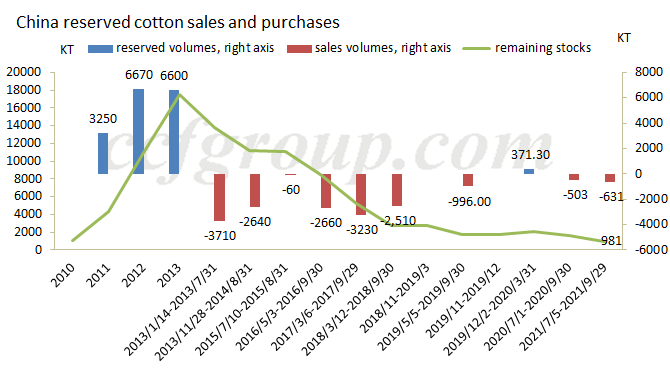A series of policies cool down Chinese cotton market
Seed cotton prices in Xinjiang rose strongly during the National Day holiday (Oct 1-7), and on the first trading day returning from the holiday, Zhengzhou cotton futures market hit the up limit directly, with Jan’21 cotton contract closing at 21,255yuan/mt, up 1,250yuan/mt. In the meantime, the state cotton reserves policy continues to be implemented, and Chinatex and China National Cotton Group sells reserved imported cotton to the market. In addition, Agricultural Development Bank of China requires a higher margin for Xinjiang ginners. With the fierce competition for seed cotton procurement, this series of policies try to cool down the market.
On Oct 7, China Reserve Cotton Management Co., Ltd. announced to sell reserved cotton via auction in Oct-Nov. The daily selling volumes were around 15,000 tons in principle, which would be dynamically adjusted according to the market situation. The reserved cotton could be only purchased by textile enterprises and could not be resold.

If the daily planned selling volumes are 15,000 tons, the total planned selling volumes may be 585,000 tons in Oct-Nov as there are 39 working days during the two months. From Jul 5 to Sep 29, the reserved cotton selling volumes have reached 630,000 tons. The remaining stocks of reserved cotton in state warehouses are assessed at 980,000 tons, including 610,000 tons of 2011/12-2013/14 cotton and 370,000 tons of 2019/20 cotton. According to the sources on Oct 8, the cotton sold is mainly the 2013/14 cotton. This round of state reserves sales could basically deplete the old cotton in state warehouses.
Viewed from the supply on spot market, the 150,000 tons of reserved cotton from the government are mainly the low-grade cotton. On Oct 8, Chinatex planned to sell 10,000 tons of imported cotton and China National Cotton Group planned to sell 18,000 tons. The total quantity to the market reached 43,000 tons, which could meet spinning mills’demand. If this volumes maintain around 20 days, it could meet spinners’one month of cotton demand. The spot cotton supply is not tight with the daily volumes of about 43kt. Nevertheless, the reserved cotton and imported cotton only has relative price edge, and its absolute prices have been much higher than previous period. On the first trading day, spinners have good demand for quality imported cotton, and sales were fast. For example, Brazilian cotton, Middling, 1-1/8, was traded at 900-1000yuan/mt premium to Jan contract, slightly lower than the mainstream basis.
Viewed from the supply and demand, the release of relative policies could meet the industry demand effectively, but the logic of cotton futures is more on the large price spread between spot and futures market and the difficulty to register warehouse receipts on Jan contract. For seed cotton procurement, Agricultural Development Bank of China requires a higher margin for Xinjiang ginners, and some larger state-owned ginners stop purchasing. The effect remains to be seen. In general, the procurement progress in Xinjiang is slightly slower than the same period of last year. In addition, machine-picked seed cotton arrives on the market successively in both North and South Xinjiang. Though the picking machines increase this year, there is still no enough machines in some regions, like Kuitun. Some growers are willing to sell, but have difficulty in picking, leading to slower progress.
- Top keywords
- Cotton Price
- Cotton Futures Price
- Cotton Futures
- CZCE
- PTA Futures Price
- Chemical Fiber
- Polyester Prices
- Wool price
- PTA Futures
- Shengze Silk
- China
- Yarn Price
- price
- China Textile City
- Fibre Price
- Benzene Price
- Cotton
- Index
- Cotton Index
- PTA
- fabric price
- NYMEX
- Top 10
- textile industry
- Spot Cotton
- Cotton Yarn
- Polyester Price
- Futures
- PTA Price
- cotton yarn price

